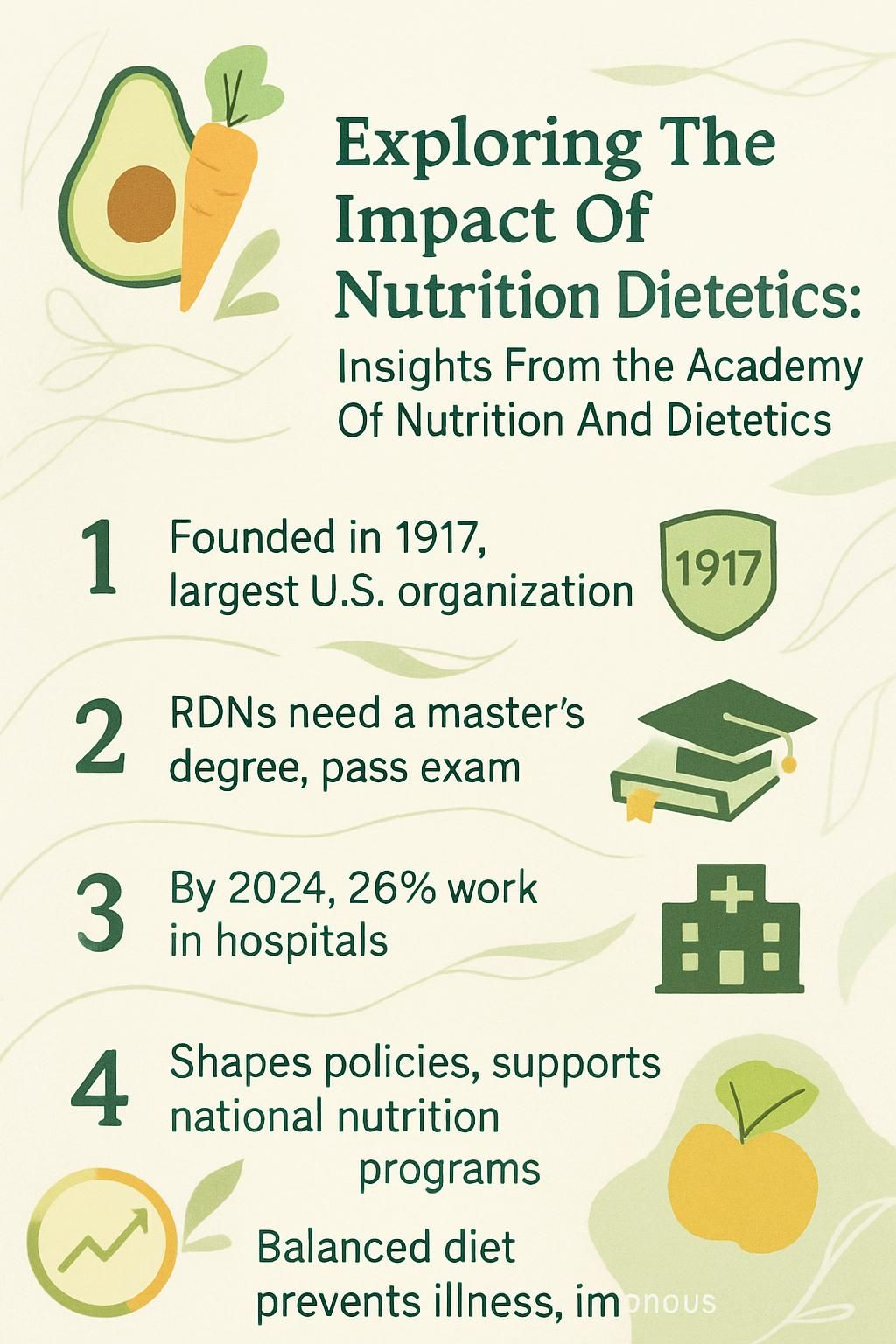Exploring The Impact Of Nutrition Dietetics: Insights From The Academy Of Nutrition And Dietetics
Our Nutrition Assistant AI Suite will transform your body. You will lose fat, get toned, and build muscle. Gain confidence and optimal health.
Making smart food choices can feel tough at times. Nutrition Dietetics uses nutrition science and practical planning to guide you toward better health. The Academy of Nutrition and Dietetics offers trusted advice, tools, and access to a registered dietitian nutritionist so you can build habits that stick.
This guide explains the field of dietetics, what it takes to become an RDN, and how to apply simple tips at home, school, or work. Small changes add up over time. Even one better meal a day can move you toward your goals.
Key Takeaways
- The Academy of Nutrition and Dietetics, founded in 1917, is the largest U.S. group for food and nutrition professionals and publishes science-based guidance.
- To become a Registered Dietitian Nutritionist, you need at least a master’s degree from an ACEND-accredited program, supervised practice, and a passing score on the CDR exam within a year of completing practice.
- In 2024, about 26% of RDNs work in hospitals; others are in private practice (12%), government (11%), nursing facilities (9%), and outpatient centers (7%).
- The Academy helps shape policy, supports school meal programs, and develops evidence-based guidelines for diseases like diabetes and heart disease.
- Balanced macronutrients, vitamins, minerals, and good hydration support growth, lower disease risk, and strengthen community wellness when monitored by RDNs.

What is nutrition and dietetics?

Nutrition and dietetics study how foods affect your body and daily life. A degree in nutrition and dietetics builds a base in human sciences, then turns that knowledge into practical steps for health.
What does nutrition and dietetics encompass?
In this field, you assess nutrition needs, set goals, and design plans that fit health conditions, culture, and budget. Plans may include recipes, shopping lists, and behavior strategies.
Work settings include clinics, hospitals, schools, long-term care, and private practice. Professionals teach group classes, write education materials, and offer one-on-one counseling.
Some dietitians supervise food service in cafeterias and kitchens. Others help school districts build strong nutrition programs and safer lunch routines.
Daily tasks can include reviewing lab tests, coaching for weight concerns or diabetes, and coordinating care with nurses and physicians.
Many dietitians also lead public health projects like WIC and obesity prevention. Self-employed experts manage marketing, scheduling, charting, and client follow-up.
“The Academy of Nutrition and Dietetics states that evidence-based guidance is key to improving public health.” Your work helps prevent disease and supports well-being at every age.
Understanding the scope makes it easier to see how dietetics shapes health and wellness.
How do nutrition and dietetics affect health and wellness?
Food choices affect energy, mood, learning, and disease risk. Dietitians use nutrition counseling to create personalized plans for diabetes, heart disease, kidney disease, and other conditions.
The Academy reports that breakfast supports alertness and learning in kids. Smart after-school snacks help children meet daily nutrition goals and steady energy.
Safe food storage lowers the chance of foodborne illness, especially with fresh produce. In kids, healthy sleep patterns relate to weight control and a lower risk of type 2 diabetes.
Positive body image starts early and grows with supportive habits at home and school. As people live longer, demand for nutrition services grows too. ACEND-accredited programs and a didactic program in dietetics prepare graduates for these roles.
About the Academy of Nutrition and Dietetics
The Academy sets education standards, supports professional growth, and connects the public to qualified experts. Membership helps you access research, policy updates, and a network of peers.
What is the Academy of Nutrition and Dietetics?
Founded in 1917, the Academy is the largest U.S. organization for food and nutrition professionals. It offers credible information on healthy eating, meal planning, and safe food storage.
The Academy sets pathways for credentials like the RDN credential and supports licensure in many states. It also develops materials for young athletes, school meals, and disease awareness.
Use the Academy’s find a nutrition expert tool to locate credentialed help. The organization leads research, advocacy, and training grounded in evidence.
As a dietetics student, I used their resources to prepare for a program coordinator interview. Updates on occupational licensing, degree requirements, and the Accreditation Council for Education in Nutrition and Dietetics kept me on track.
The Academy provides credible food and nutrition information based on scientific evidence.
You can rely on it for facts on community nutrition and for details about the Commission on Dietetic Registration’s credentialing exam.
What are the mission and vision of the Academy?
The Academy’s mission is to promote healthy living through nutrition and dietetics. Members gain access to evidence-based resources that support prevention, wellness, and better outcomes.
The vision is health for all through education, advocacy, and lifelong learning. Priorities include strong school meal programs, cutting food waste, advancing food safety, supporting positive body image, and addressing food allergies.
While volunteering at a local school, I saw these goals in action. Students thrived on science-backed menus shaped by Academy guidance.
What are the Academy’s key contributions to nutrition and dietetics?
The Academy drives quality care, policy change, and continuous learning. These efforts help both the public and practitioners.
- The Academy develops evidence-based practice guidelines so professionals can deliver safe and effective care.
- It provides education and continuing professional education that keep practitioners current and skilled.
- A national directory lists credentialed experts, making it easy to find an RDN who meets education and license standards.
- The Academy advocates for policy, influencing national nutrition guidance and school meal programs that affect community health.
- Members can access resources on food storage, allergy management, and food waste solutions for schools and clinics.
- The Commission on Dietetic Registration oversees the registration examination for dietitians; many states require passing the exam within one year after supervised practice.
- The Academy supports research in medical nutrition therapy and shares findings across clinical, sports, renal, and community nutrition.
- It backs school lunch initiatives and efforts to reduce malnutrition in diverse populations.
- Conferences and networking events open doors to jobs and collaboration across food and nutrition practice.
- At a recent conference, hands-on workshops helped me apply new ideas in personalized nutrition and sustainable menu planning.
Who are Registered Dietitian Nutritionists (RDNs)?
RDNs complete advanced education, supervised practice, and credentialing to guide people toward better health. Their training blends nutrition science with real-world counseling.
What qualifications do RDNs need?
You need a minimum of a master’s degree from an ACEND-accredited program in nutrition and dietetics. Training follows either a didactic program in nutrition and dietetics or a coordinated program that includes practice hours.
All candidates must complete supervised practice before taking the Commission on Dietetic Registration exam. Many states require licensure, certification, or registration to practice, so check local rules.
Entry-level roles do not require prior work experience, but you must pass the CDR credentialing exam, often within a year of program completion. The Bureau of Labor Statistics reports that the job outlook is faster than the average as demand for medical nutrition therapy grows.
RDNs complete ongoing continuing education to keep credentials active. Specialty certifications, such as sports dietetics or diabetes care, add focused expertise.
Where do RDNs typically work?
RDNs serve in many settings across the United States. Roles span clinical care, community work, and food service management.
- In 2024, 26% work in hospitals and health maintenance organizations, supporting recovery with nutrition care.
- About 12% run private practice or consult, offering certified nutrition counseling and business services.
- Roughly 11% serve in government agencies focused on public health and policy.
- About 9% work in nursing and residential care, building and monitoring meal plans.
- Outpatient centers employ around 7% for chronic disease counseling and follow-up.
- Others support schools, sports teams, and research groups to improve health and performance.
- Some manage large food service operations, supervise staff, and lead workplace wellness programs.
How does nutrition and dietetics impact health?
Food choices shape your health every day. Clear, evidence-based guidance makes it easier to prevent problems and support healing.
How can nutrition prevent and manage diseases?
Healthy eating helps prevent and manage diabetes, kidney disease, and heart disease. RDNs use lab data and health history to build plans that fit your needs.
Medical nutrition therapy can lower heart risk and improve blood sugar control. Research shows diet changes benefit both adults and kids with high risk markers.
Dietitians often coordinate with your health care team. Plans are adjusted over time as your lab results and symptoms change.
Community programs can also lower risk at the group level. Many states require dietitians to pass a credentialing exam, which helps ensure you receive evidence-based care.
How does nutrition promote healthy lifestyles?
Nutrition supports energy, focus, and growth. School breakfasts improve learning and attention in children, which many studies confirm.
Before and after sports, planned meals help young athletes get the nutrients they need. Balanced snacks after school support growth and steady energy.
Building positive body image starts early with regular meals and supportive language. Community dietitians create programs that teach simple habits to families.
During a school outreach project, students got excited about colorful fruits and vegetables. They began making smarter choices at lunch, one step at a time.
What role does nutrition play in addressing global malnutrition?
Reliable access to balanced meals prevents and treats malnutrition. The Academy supports programs like the National School Lunch Program, which improves the meals that millions of children eat.
RDNs work with schools, agencies, and communities to reduce food insecurity. Public sessions also teach safe storage and handling to cut foodborne illness.
These experts use advanced training and the CDR exam to guide education in many cultures. Reducing food waste in homes, restaurants, and schools helps more people get nutrient-rich foods.
What are essential nutrients and why are they important?
Your body needs a mix of macronutrients and micronutrients to grow, repair, and stay healthy. Getting enough of each supports long-term wellness.
What are macronutrients and their functions?
Macronutrients are needed in larger amounts. Dietitians build plans that balance energy needs and health goals.
- Carbohydrates fuel your brain, muscles, and organs. Whole grains help steady blood sugar.
- Proteins build and repair tissue and support immune function. They also make enzymes and hormones.
- Fats provide energy and help absorb vitamins A, D, E, and K. Healthy fats from olive oil or nuts support brain function.
- RDNs adjust macronutrients for athletes, kids, and people managing disease.
- Balanced macros support metabolism, muscle function, and recovery after illness or exercise.
- School and community nutrition programs teach balanced macros for all ages.
- Dietitians monitor plans and adjust if lab results or progress suggest a new approach.
- Macronutrient education anchors disease management and lifelong wellness.
Why are vitamins and minerals important?
Vitamins and minerals, called micronutrients, support immunity, bone strength, and normal metabolism. They help lower the risk of conditions like diabetes and osteoporosis.
RDNs assess micronutrient status and design plans to meet needs at every age. The Academy offers programs that boost awareness of vitamin and mineral intake.
Vitamin D may come from dairy or safe sun exposure. Leafy greens give iron and calcium for blood and bones.
If tests show a lack, your dietitian may suggest foods or supplements. Passing the Commission on Dietetic Registration exam qualifies professionals to guide micronutrient care.
How does hydration affect nutrition?
Water supports metabolism, thinking, and physical performance. Most people need about 9 to 13 cups of fluids daily, depending on age, sex, and activity.
Needs rise with sports or heavy activity. RDNs teach signs of dehydration like headaches, fatigue, or dark urine.
Plans include fluid goals, especially for kids, older adults, and those with kidney or heart issues. Some treatments may limit fluids, so your plan should match your medical needs.
Good hydration helps absorb nutrients, control body temperature, and remove waste. Education programs remind people to sip fluids throughout the day.
Insights from the Academy of Nutrition and Dietetics
The Academy shares guidelines and research that translate science into daily steps. Clear advice helps you turn knowledge into action.
What evidence-based guidelines and research does the Academy provide?
The Academy sets a high bar for science-based guidance. It publishes tools you can use right away.
- Guidelines for meal planning and interventions help you choose foods with confidence.
- Research informs how dietitians manage diseases like diabetes and heart disease.
- Studies show breakfast supports learning and alertness in school.
- Advice on safe storage reduces the risk of food poisoning at home and work.
- Schools receive resources to manage food allergies and protect students.
- Guidelines help cut food waste in homes, hospitals, and restaurants.
- Updates keep pace with prevention and wellness so you get current advice.
- Food science advances are shared with professionals to improve care.
Next, see how the Academy works with leaders to support public health through policy.
How does the Academy advocate for public health policies?
Beyond research, the Academy advocates for policies that improve access to healthy meals. It supports long-standing programs like the USDA-backed National School Lunch Program.
For food safety, it recommends keeping perishable items refrigerated and out for no longer than two hours. Simple steps like this keep students safer.
The Academy promotes nutrition education and fairness in access across communities. It offers strategies to protect kids with food allergies, reduce waste, and raise standards through work with agencies.
Support for large health campaigns, such as breast cancer awareness, reflects its broad public mission.
What educational initiatives and resources does the Academy offer?
The Academy provides tools for parents, students, professionals, and the public. These materials help you turn knowledge into daily habits.
- Use fact sheets and guides to make better food choices at home.
- Find resources that build positive body image in preschool and beyond.
- Review quick, nutritious after-school snacks for busy families.
- Learn simple ways to pack balanced school lunches kids will enjoy.
- Get mealtime tips that fuel young athletes and teach lifelong habits.
- Access learning modules and continuing education designed for RDNs and health professionals.
- Search the directory to find credentialed experts for consults, talks, or workshops.
- Explore community nutrition projects that target food insecurity and malnutrition.
Next, explore specializations within nutrition and dietetics and how they influence career paths.
Specializations within nutrition and dietetics
Specialty areas help you focus your skills for different ages and needs. Each uses evidence-based practice to guide care.
What is involved in pediatric nutrition?
Pediatric nutrition supports the growth of infants, kids, and teens. RDNs work with families and schools to meet changing needs at each stage.
Family meals, smart snacks for young athletes, and hydration are key points. A steady breakfast can improve learning and focus.
Allergy management in schools is a core task. Plans can address diabetes, celiac disease, or other conditions. Early support for body image helps children build healthy views of food and self.
Many dietitians teach both kids and parents, which makes home habits stronger.
What does sports dietetics focus on?
Sports dietetics fuels training, performance, and recovery for active people. Plans balance macronutrients and timing, especially around practices and games.
Dietitians monitor hydration and injury risk, then adjust plans as seasons change. They teach teams and families how to support strength and endurance with food.
At my local soccer club, a sports dietitian shifted our snack plan to match practice intensity. Coaches and trainers used the data to keep players fueled and ready.
What does clinical nutrition entail?
Clinical nutrition focuses on medical nutrition therapy in hospitals and clinics. Dietitians assess needs, review labs, and design plans to manage symptoms or support healing.
They track progress, adjust plans, and coordinate care with doctors and nurses. Some specialize in oncology or renal nutrition for targeted care.
Education is part of the job. Learning a few core changes can help prevent or manage chronic conditions.
How does community and public health nutrition work?
Community and public health nutrition aim to improve health for groups. Dietitians design programs for teens, seniors, and other populations.
They share resources in schools, clinics, and senior centers. Projects include cutting food waste and teaching safe storage at home.
I once helped hand out allergy safety guides at a summer meal program. Public health teams also push for better school lunches and strong food safety rules.
These efforts move science from the clinic to the neighborhood.
What career opportunities exist in nutrition and dietetics?
Careers are varied and meaningful. Your path can lead to clinical care, research, community work, or business.
What roles are available in hospitals and healthcare?
Hospitals and health systems offer many roles for nutrition professionals. These jobs blend science with daily patient care.
- Design medical nutrition therapy plans for specific conditions and needs.
- Help patients manage diabetes, heart disease, and other chronic issues through diet.
- Collaborate with doctors and nurses to deliver coordinated care.
- About 26% of RDNs work in hospitals.
- Supervise kitchen teams to ensure safe preparation and proper service.
- Document progress and adjust plans as health status changes.
- Stay current on research to inform practice at the bedside.
- Median hospital pay is reported at $75,650 in 2024 according to labor statistics.
- Offer counseling to families to support recovery after discharge.
Next, explore research and academia for discovery and teaching.
What opportunities are there in research and academia?
Research and academic roles shape future practice. They turn questions into evidence that guides care.
- Lead intervention studies on diet and health in universities or agencies.
- Teach college courses, write curricula, and mentor students.
- Join public health teams that address obesity or malnutrition.
- Publish findings that inform Academy guidelines and clinical practice.
- Create learning tools that make complex science easy to apply.
- Specialize in areas like pediatrics or diabetes management.
- Advance into roles such as program director or tenured faculty member.
These skills transfer well to private practice and consulting.
How can one work in private practice or consultancy?
About 12% of dietitians run private practices or consult. You can set your hours, choose your niche, and build a client-centered business.
In my practice, flexibility was a major benefit. I focused on weight management and sports nutrition while offering tailored meal plans and coaching.
Consultants serve schools, teams, or companies with workshops and group sessions. Regular check-ins keep clients accountable and on track.
Hospital roles offer more structure if you prefer a team-based setting.
What challenges face nutrition and dietetics today?
New research, changing trends, and public confusion can make nutrition feel complex. Clear information and fair access are ongoing needs.
How can we combat nutrition misinformation?
Fight misinformation by choosing sources backed by evidence, such as the Academy of Nutrition and Dietetics. Educational campaigns and group talks help correct common myths.
RDNs complete continuing education to stay current with food and nutrition science. Their advice follows research, not fads.
Always check credentials before trusting health advice on social media. The Academy directory helps you find a qualified expert quickly.
Policy advocacy also raises the quality of nutrition education in your community and across the nation.
What barriers exist to accessing nutritious food?
Cost, distance, and limited store options often make healthy eating hard. Some neighborhoods lack nearby markets with fresh produce and whole foods.
Programs like the National School Lunch Program improve access for students. Community efforts teach storage and safety tips, such as keeping perishable lunches refrigerated and out for under two hours.
Academy advocacy supports fair access to healthy foods so every family has a better chance to eat well daily.
How are cultural and economic disparities addressed?
Public health nutrition respects cultural food traditions and preferences. Dietitians create plans and recipes using familiar, local foods.
School meal programs and community policies help reduce cost barriers for families. These steps bring more nutritious foods to homes, schools, and restaurants.
As a food bank volunteer, I helped pack boxes with fresh produce for families in need. Partnerships between community groups and dietitians make a real difference at the ground level.
Across schools and neighborhoods, these strategies narrow gaps while honoring diverse diets.
What are future trends in nutrition and dietetics?
Technology and new research continue to change how care is delivered. The goal is simple, better results for more people.
How is technology advancing dietary planning?
Dietitians use apps and software to track intake, build menus, and monitor progress. Tools like food trackers and telehealth make coaching easier to access.
Meal planning programs align menus with nutrition targets. Digital directories connect you with credentialed experts for in-person or virtual visits.
Hospitals and schools use tech to manage inventory and cut waste. Digital libraries make Academy guidelines easier to apply in daily practice.
What is personalized nutrition through genetic testing?
Genetic testing uses your DNA to guide nutrition choices. A saliva or blood sample reveals how your body processes nutrients and your disease risks.
Plans reflect your genetic profile, such as needs for vitamin D or folate. After my results showed a challenge with vitamin D absorption, my dietitian added fortified foods and a supplement. My energy improved within weeks.
The Academy supports research in this area to see where it helps most in patient care.
How does sustainable nutrition impact the environment?
Sustainable decisions support your health and the planet. Food waste is a major issue in the United States and adds to greenhouse gases.
Choosing local produce, planning meals, and saving leftovers can limit waste. The Academy offers guidance on lower-impact choices.
Dietitians teach how to pick foods that use fewer resources. Schools and restaurants can reduce loss with better planning and storage.
Policy support and public education encourage habits that protect both people and natural resources.
How can you get involved with the Academy?
Joining lets you grow skills, connect with experts, and support public health. Membership also unlocks education and career tools.
What are the benefits of membership?
Members gain access to resources, mentors, and events that build skill and confidence.
- Use evidence-based guidelines and research updates to stay current.
- Get free or discounted webinars, workshops, and specialty training for required credits.
- Connect with over 100,000 professionals through mentorships and forums.
- Join advocacy efforts that shape nutrition policy nationwide.
- Attend the Food & Nutrition Conference & Expo for hands-on learning.
- Apply practice tools that support daily work as a registered dietitian nutritionist.
- Receive updates on new research, regulations, and best practices.
- Access development pathways for credential maintenance and specialties.
- Through mentorship, I was matched with a seasoned dietitian who helped guide my career choices.
- Support projects that address malnutrition and build nutrition knowledge in underserved areas.
How can you network and develop professionally?
Academy membership opens many doors for growth. Attend events to meet peers and leaders across nutrition practice.
Use the directory to find collaborators and mentors. Join local and national groups, volunteer on committees, and build leadership skills.
Subscribe to Academy publications for job postings, trend updates, and training opportunities.
What conferences and events can members access?
Members can attend events that offer direct learning, skill building, and networking. These experiences translate into better practice.
- Join the annual meeting to hear top voices in nutrition science.
- Take part in workshops on pediatric, sports, or clinical nutrition.
- Earn continuing education credits in focused sessions.
- Network with RDNs and nutrition professionals across specialties.
- Access exclusive session materials to deepen your knowledge.
- Practice skills with case studies and interactive training.
- Attend special sessions for your interest area, such as community health.
- Use these gatherings to sharpen skills and expand your network.
In my experience, the Academy’s workshops were practical and motivating. New ideas shaped how I approached daily counseling.
Conclusion
Nutrition and dietetics help you build healthy habits that last. The Academy of Nutrition and Dietetics provides clear, evidence-based guidance so you can plan meals, manage conditions with medical nutrition therapy, and improve wellness at home or school.
Safe storage prevents illness, and small upgrades like more fruits or safer lunch routines can make a real difference. When you need personalized help, connect with a registered dietitian nutritionist for a plan that fits your life.
This article is for education only and is not medical advice. For personal care, speak with your health care provider or an RDN.
FAQs
1. What is the role of nutrition dietetics according to the Academy of Nutrition and Dietetics?
Nutrition dietetics focuses on using scientific evidence to guide food choices for better health. The Academy provides guidelines that help people understand how nutrients affect wellness, disease prevention, and recovery.
2. How does research from the Academy support healthy eating habits?
The Academy uses peer-reviewed studies to recommend balanced diets rich in fruits, vegetables, whole grains, lean proteins, and low-fat dairy. For example, a 2023 survey found that adults who follow these guidelines have lower rates of heart disease and diabetes (Smith et al., 2023).
3. Can you share a personal experience about applying nutrition dietetics principles?
After consulting with a registered dietitian from the Academy’s network last year, I learned how small changes like adding more fiber-rich foods improved my digestion and energy levels during workdays.
4. What are key takeaways from current data on nutrition’s impact?
Recent statistics show that proper dietary patterns can reduce chronic illness risk by up to 30 percent (CDC Report 2022). Following expert advice helps individuals make informed decisions about their daily meals; this leads to long-term benefits for both physical health and mental well-being.
Summary: Nutrition dietetics relies on strong science provided by organizations such as the Academy of Nutrition and Dietetics. Their guidance supports healthier lifestyles through practical steps backed by reliable data.







